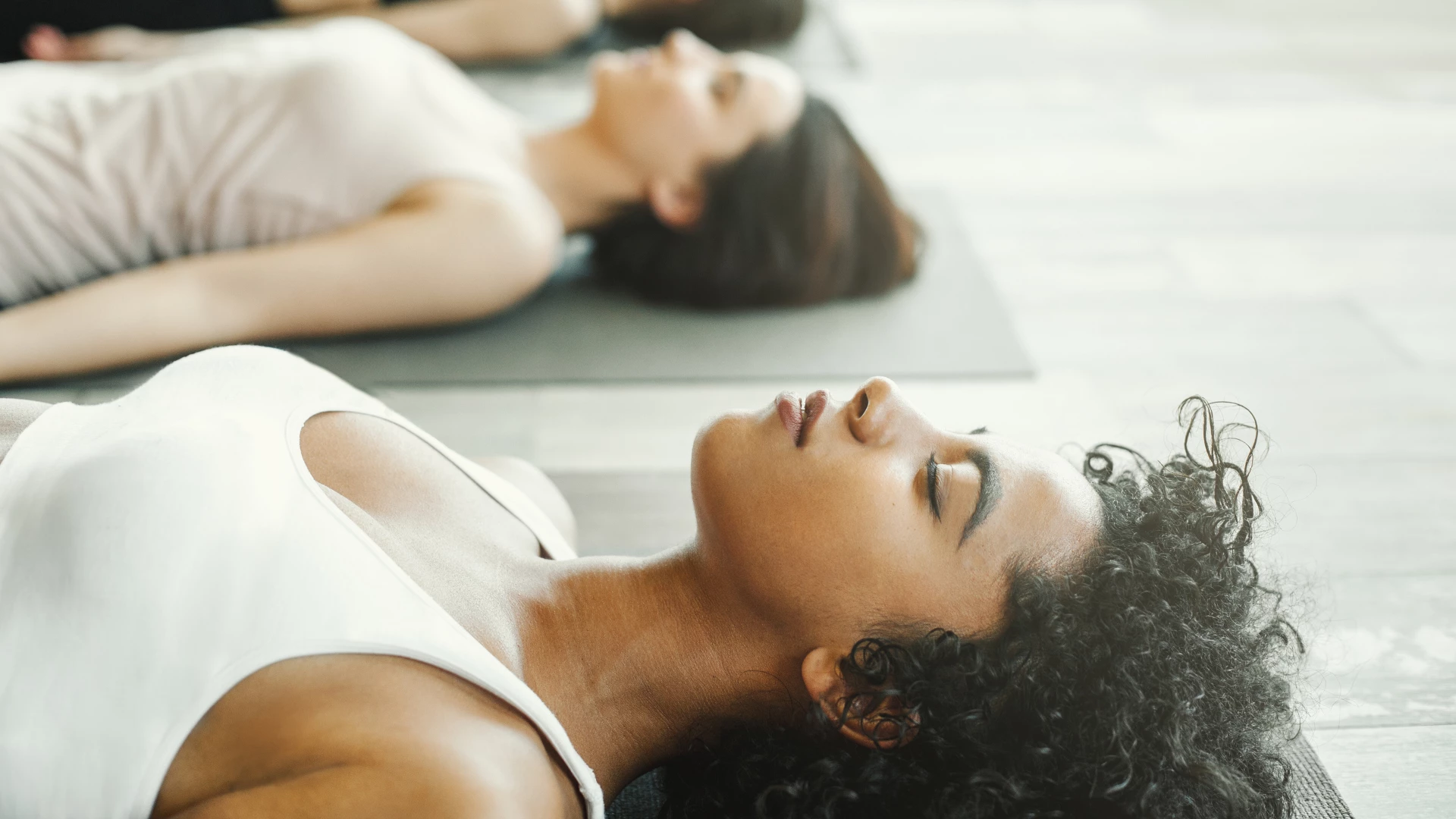7 Amazing Benefits of Yoga Nidra

Article At A Glance
Yoga Nidra is a form of guided meditation also known as “yogic sleep” or “effortless relaxation.” It’s usually practiced lying down with a yoga teacher guiding the session. The goal is for the body to be completely relaxed while the mind is awake and focused inward. During the course of Yoga Nidra, you learn to surf between the states of wakefulness and sleep, where your body finds its natural state of equilibrium (homeostasis) and the breath balances and becomes quiet. Practicing Yoga Nidra can improve sleep and memory, reduce stress and anxiety, and help manage PTSD.
What if I told you you could do a life-changing yoga practice that never requires you to get up off the floor? In fact, no physical movement is needed whatsoever. Sounds too good to be true? It isn’t. The practice of Yoga Nidra is a deeply restful, rejuvenating and healing practice that helps to reduce anxiety, improve cognition and support restful sleep. As an added bonus, it is accessible to everyone, no matter your age or level of physical fitness.
What is Yoga Nidra?
Yoga Nidra (pronounced nih-drah) is a form of guided meditation also known as “yogic sleep” or “effortless relaxation.” It’s usually practiced lying down with a yoga teacher guiding the session. The goal is for the body to be completely relaxed while the mind is awake and focused inward.
During the course of Yoga Nidra, you learn to surf between the states of wakefulness and sleep, where your body finds its natural state of equilibrium (homeostasis) and the breath balances and becomes quiet. In this state, you can access the subtle flow of energy, called prana, in the body. One of the goals of this practice is to identify and remove blockages to its flow.
7 Life-Changing Benefits of Yoga Nidra
Yoga Nidra can be as restorative as sleep, giving your mind and body an extra window of deep relaxation, offering powerful benefits for mind, body and spirit. While each individual will find growth, healing and self-discovery in unique ways, here are seven common benefits:
-
Getting the ZZZs You Need

It is common knowledge that lack of sleep contributes to a whole list of other stresses including burnout, depression and a weakened immune system. That’s why it is important to get enough. The National Sleep Foundation recommends that adults get seven to nine hours of sleep every night.
Yoga Nidra can help by training the mind and body to relax and move more easily into the deeper states of sleep. Incorporating Yoga Nidra at bedtime can help you fall asleep faster and stay asleep longer.
How? Yoga Nidra slows the wavelengths in your mind as you enter a sleep-like state. It can take you into two of the four sleep stages and brain waves; Alpha brain wave (NREM stage 1) and Theta waves (NREM stage 2). It is also believed that experienced practitioners may reach Delta waves, the final two sleep state stages.
So while you cannot catch up on missed sleep, doing Yoga Nidra is a good way to supplement your sleep. Some claim that 45 minutes of Yoga Nidra is equal to up to 3 hours of sleep. While there is no scientific research to support this, it’s still worth trying, especially right before bed to help prepare yourself for a more restful night’s sleep.
-
Calming Anxiety and Stress Levels
Practicing Yoga Nidra slows mental activities and rebalances the nervous system. As discussed in #1, it promotes deep rest and relaxation that isn’t found in other meditation practices, calming the nervous system leading to less stress and better overall health.
Research shows that Yoga Nidra brings improvements in emotional self-regulation and can reduce levels of depression, stress and anxiety. The end result is increased mood, quality of life and well-being.
A 2018 study published in the International Journal of Yoga found that Yoga Nidra was more effective than meditation in reducing both cognitive and physiological symptoms of anxiety. This includes a reduction in stress hormones (such as cortisol and epinephrine), which when chronically elevated, can lead to inflammation, heart disease, fatigue, stroke, sleep disorders and chronic pain.
Similarly, another study looked at heart rate variability (HRT), which is a sign of autonomic nervous system balance. Researchers found that Yoga Nidra (alone or preceded by an asana practice) improved HRT by shifting the balance of your nervous system from a stressed state to a relaxed one.

-
Reducing Symptoms of Post-traumatic Stress Disorder (PTSD)
Yoga Nidra goes beyond helping alleviate everyday stress and has been shown to be an effective treatment for chronic stress and psychological problems, such as PTSD.
In 2011, a study was carried out on military combat veterans who practiced Yoga Nidra weekly. All 11 participants who completed the study claimed they experienced positive benefits such as reduced rage, anxiety, emotional tension and a drop in intrusive memories.
-
Releasing Tension and Reducing Pain
Sleep is the best medicine for an illness or injury. The sleep-like relaxation state and slow brain waves evoked by the practice of Yoga Nidra stimulates the healing response, just like when you sleep.
A 2012 study in India explored the effect of Yoga Nidra on patients suffering from rheumatoid arthritis. It found that participants experienced significant relief in pain, tenderness, stiffness, and swelling of the joints after practicing Yoga Nidra. Patients reported a feeling of well-being, lightness in the body, and improvement in mental, emotional, and muscular tension.
The practice of yogic sleep gives the body time to rest, recover and restore. The result? Less inflammation and improved functioning of the immune system.
-
Managing Symptoms of Type 2 Diabetes
If you are diabetic, what you put into your body is always top of mind, but there are other factors that cause hypoglycemia, including stress. A 2009 study published in the Indian Journal of Physiology and Pharmacology found Yoga Nidra effective in both reducing the symptoms of diabetes and helping to control blood glucose levels.
Researchers administered either a Yoga Nidra program and oral hypoglycemic drugs or oral hypoglycemic drugs alone to 41 diabetics for 90 days. The yoga group participated in Yoga Nidra practice for 30 minutes daily. Blood tests were obtained from the participants every 30 days. The researchers found that the yoga group had improved diabetes symptoms compared to the drug-only group. Furthermore, blood glucose levels were significantly improved in the yoga group.
-
Enhancing Cognition and Memory

There are two factors involved in the process of memory. The first is the brain’s ability to absorb information, and the second is its ability to recall that information. Yoga Nidra works on both of these levels by establishing a state of maximum receptivity in the subconscious mind, along with a simultaneous state of awareness.
8 Stages of Yoga Nidra

This enhanced cognitive performance results from the brain training through the eight stages of Yoga Nidra:
Step 1: Initial Relaxation/Settling
This first stage is about settling into the practice by relaxing your body and turning your attention inward.
Step 2: Setting an Intention or Sankalpa
Setting a Sankalpa helps train your mind to stay focused and brings more purpose and direction into the practice.
Step 3: Body Rotation
The systematic conscious relaxation of every part of the body to release physical tension.
Step 4: Breathing Awareness
Focus on the breath draws you into an even deeper state of relaxation by moving your attention inward and away from the external world.
Step 5: Experience of Opposite Sensations
Experience opposite feelings and sensations in your body, such as hot and cold.
Step 6: Visualization
By visualizing a series of objects or a particular scenario, such as climbing a mountain path, your awareness is drawn more deeply within.
Step 7: Sankalpa
Revisiting your Sankalpa at the end of the session enables it to sink deeply into your subconscious.
Step 8: Externalization
To end the practice, the instructor guides you to slowly bring your awareness back to your breath, the body and finally, the external environment to reawaken.
-
Promoting Healing

Yoga Nidra is a powerful healing practice for body, mind and consciousness. Your body is a densely packed field of energy. Through this field, prana, or life energy, flows through the 72,000 different channels (called nadi) described in yoga. Every thought and feeling produces a change in the flow of prana. In essence, prana controls the functioning of our body.
When the flow of prana is disturbed, the systems of the body function less than optimally and define our suffering, both physically and emotionally. The practice of Yoga Nidra restores the flow of prana, allowing your body’s systems to function properly.
Yoga Nidra also maximizes the potential of the body and mind to heal itself and can be practiced to support healing from any condition. In a natural, relaxed state, the mind is calm, and the body functions well.
However, when the mind becomes agitated, the physiology of the body is altered. The immune system fails, and the body becomes sick. Yoga Nidra gets the mind back to a state of calmness and improves the functioning of the immune system.
Also, read...
Free Yoga Video: Breathing for Pelvic Floor Health: Two Practices to Deepen Your Breath
May 06 – By: YogaUOnline Staff
How Healthy Is Your Nervous System: Polyvagal Theory Made Simple
Apr 15 – Dr. Arielle Schwartz & Eva Norlyk Smith, Ph.D.
Related courses
Breath as Medicine: Yogic Breathing for Vital Aging
With Doug Keller
Yoga and Myofascial Release: Releasing Chronic Tension with the Bodymind Ballwork Method
With Ellen Saltonstall
Reprinted with permission from Beverly Davis-Baird/WisdomTreeYoga.

Beverly Davis-Baird, MA, e-RYT200/RYT 500, C-IAYT is a New Jersey-based yoga therapist, writer, and educator. She specializes in making yoga accessible for adults 50+, offering classes and workshops for back care, arthritis, bone health, balance, posture, and healthy aging. An educator at heart with over 20 years of experience as a public school teacher, Beverly brings her knowledge of individual learning styles to her classes, providing instruction that is clear, concise, inclusive, and compassionate. Bringing over 30 years of experience and training, she considers herself a lifelong learner and believes that the practice of yoga should bring spaciousness and release from tension, not create it. As such, she strives to make yoga accessible to people of differing abilities, believing the real benefits of yoga come from what is taken with you outside of class and into your life. To read her blog or learn more about her teaching schedule and latest offerings, please visit www.wisdomtreeyoga.com.
Recent articles
Change Your Perspective of Pelvic Tilting: How the Transversus Abdominis Can Help
Jul 08 – Olga Kabel C-IAYT
Warrior I Pose: 5 Strengthening Variations
Jul 02 – Bridget Frederick, eRYT 500
4 Ways to Practice Locust Pose
Jun 30 – Baxter Bell, MD, eRYT 500, C-IAYT
Categories
Upcoming courses
Breath as Medicine: Yogic Breathing for Vital Aging
With Doug Keller
Yoga and Myofascial Release: Releasing Chronic Tension with the Bodymind Ballwork Method
With Ellen Saltonstall
JOIN NOW!
Recent articles
Almost there...
Sorry, we couldn't find anything...
Pose Library
Change Your Perspective of Pelvic Tilting: How the Transversus Abdominis Can Help
“Tuck your tailbone under” or “lengthen your tailbone” have long been among the most…
Jul 08 – Olga Kabel C-IAYT
Yoga Practice Tips
Warrior I Pose: 5 Strengthening Variations
Warrior I Pose (Virabhadrasana I) is an excellent pose for strengthening your whole back…
Jul 02 – Bridget Frederick, eRYT 500
Pose Library
4 Ways to Practice Locust Pose
Locust Pose (Salabhasana) is a simple backbend that strengthens the entire back of your…
Jun 30 – Baxter Bell, MD, eRYT 500, C-IAYT



